课堂用语(2)
英语教师使用课堂用语大全

英语教师使用课堂用语大全首都师范大学外语学院张旭第1页共16页实用课堂用语(一) 1. 上课Class begins./ It’s time for class. Let’s have / start the lesson. Let’s begin our lesson.2. 起立 Stand up.3. 同学们好Good morning./ afternoon, everyone/ everybody/ boys and girls.4. 请坐 Sit down, please. Please be seated.5. 今天谁值日?Who is on duty today?6. 大家都来了吗?Is anyone absent? Is everyone here?7. 出席多少人?How many students are present?8. 班级共有多少人?How many students are there in your class?9. 谁没来?Who is not here? Who isn’t at school today? Who doesn’t come to school today?10.你知道他为什么没来吗?What’s the matter with him? Do you know?11.今天几月几日?What’s the date today?12.今天星期几?What day is it today?13.今天天气怎么样?What’s the weather like today? / How is the weather?14.今天很冷是吧? It’s very cold, isn’t it? / It’s a cold day, isn’t it?15.李雷,去看看是谁?Go and see, Li Lei.16.请进 Come in, please.17.请到座位上去,下次早点来Go to your seat, please. But don’t be late next time. Go and sit down. Come earlier next time.18.坐好了,请脱帽 Sit straight, please. Take off your cap, please.19.讲讲你星期天都做了些什么事好吗? What did you do last Sunday? Can you tell us? Would you please tell us what you did last Sunday?20.那么,你能给我们讲一个故事吗?Well, could you tell us a story?21.谁愿意到这儿来给大家讲一个故事?Who’d like to tell us a story here?22.现在该(轮到)谁了?Whose turn (is it )?23.小张,到你的了,到这来给大家讲个故事 Xiao Zhang, it’s your turn. Come here and tell us a story.24.大家注意听,然后就他讲的故事进行问答. Listen to him carefully, then ask and answer about the story.25.就你所喜欢的话题进行对话.Make a dialogue in pairs about any topics you like.26.好了,该学第八课了.Well, it’s time to learn Lesson 8. Well, let’s learn the 8th lesson.27.今天这节课,我们学习新课,第八课.Today in this class we’ll learn a new lesson, Lesson 8.28.学习新课前,我们复习一下第七课的生词和短语.Before the new lesson Let’s revise / go over the new words and phrases in Lesson 7.29.拿出练习本来,我们来听写.Take out your exercise books. Let’s have a dictation.30.我要叫两个学生到黑板上来写. I’d like two students to write on the blackboard. 31.谁愿来写?Any volunteers? Who would like to do it here? Who would like to come here and write on the blackboard?32.准备好了吗?开始! Are you ready? (Let’s) Begin.33.就听写到这,把你们写的交上来. So much for the dictation. Please hand them in. 34.现在看图,两人一组进行问答.Now look at the pictures, then ask and answer in pairs.35.谈论这幅图,(可多可少).Talk about the picture. (You can say more or less). Say something about the picture.36.表演第七课的对话.Act out the dialogue in Lesson 7. 37.看教学挂图,回答我的问题.Look at the wall charts and answer my/ the questions. 38.在图上你能看到什么?What can you see in the picture?39.还有吗?还有什么吗?Anything else / more? Any other things? 40.看图一,猜一猜发生了什么事?Look at Picture 1, and guess what ( has ) happened?实用课堂教学用语(二)1. 谁能回答这个问题?Who would like to answer this question? Who can answer it?2. 会的举手!Hands up if you can. Put up/ Raise your hands if you know the answer.3. 好,你来答.OK, you please.4. 下一个,你请来(答,做) Next / The next one, you please.5. 小李,你能回答这个问题吗?Can you (answer this one), Xiao Li?6. 小林,你呢?(你能回答吗?) What /How about you, Xiao Lin?7. 你来回答这个题好吗?Would you like to / please answer this one?8. 试一试,错了没关系.Just have a try. It doesn’t matter if you make any mistake.9. 是否正确?( Is he / that / it )Right or wrong? Yes or no?10.正确/ 错误 Right./ Yes./ Wrong. / No.11.正确吗?( Is it / that / he) Right?12.是的,正确.Yes, ( it / he) is right.13.不,不正确.No, ( it / he) is wrong.14.谁来再做一次?Who would like/ wants to do it again?16.谁能用另一种方式来做?Who can do/ say it in a different/ other way?17.谁有不同观点/ 看法? Who has a different idea/ opinion?18.你是什么观点?/ 你的看法如何?What’s your opinion?19.没听清,请你再说一遍.( I beg your ) pardon? /Excuse me? I didn’t hear it clearly. Please say it again/ repeat it.20.请大声点.( A little ) Louder, please.21.稍慢点读.Read ( a bit ) slower.22.肃静,你们最好不要在课堂上说话. Be quiet./ Keep silent. You’d better not talk in class. 23.管好自已的事/ 别管闲事.Mind your own business.24.不要朝窗外看.Don’t look out of the window.25.下面学习生词.Now word study.26.注意发音.Pay attention to your pronunciation.27.注意听我说,并观察我的动作,然后猜词意.Listen to me carefully and watch my actions, then guess the meaning of the word.28.你们听明白/ 懂了吗? Are you clear? Do you catch my idea?29.这个词是什么意思?What’s the meaning of the word?30.汉语意思是什么?The Chinese ( meaning). Give the Chinese for it.31.好了,我们学习第二部分对话. Well, let’s come to Part II, the dialogue. Well, let’s come to the dialogue in Part II.32.下面听录音,听前快速看一下黑板上的问题.Now listen to the tape. Before listening, read through the questions on the blackboard.33.听音时合上书.Close/ Shut your books while listening.。
小学教师常用英语课堂组织用语
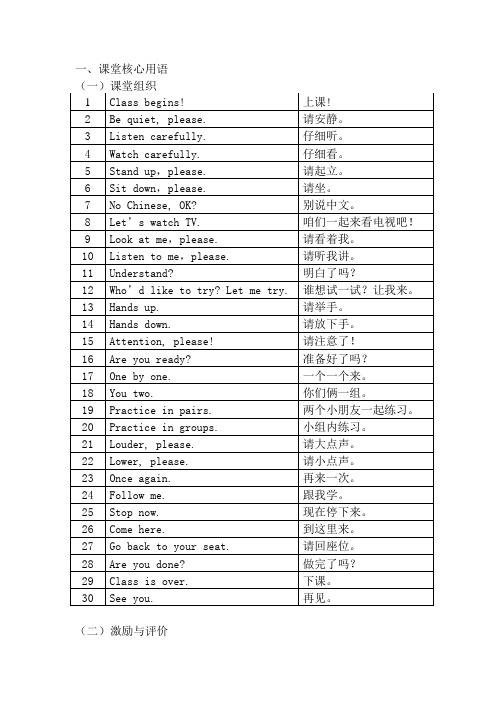
一、课堂核心用语(二)激励与评价二、课堂拓展用语小学英语课堂用语(2)一、问候用语1. Hi! 你好!2. Hello! 你们好!3. Good morning/ afternoon! 早上/下午好!4. Good morning/good afternoon, class/everyone/boys and girls! 同学们,上午/下午好!5. How are you? 你们好吗?6. Nice to meet/see you. 很高兴见到你们Nice to see/meet you again/It’s nice to see you again.很高兴再次见到你们!7. Happy Children’s Day.儿童节快乐!8. Merry Christmas Day.圣诞节快乐!9. Happy Mid-Autumn Day. 中秋快乐!10. Happy birthday to you! 祝你生日快乐!11. Happy New Year! 新年快乐!12. Happy Teachers’ Day! 教师节快乐!二、告别用语1. Bye.再见!2. Goodbye/bye-bye。
再见!3. See you!再见!4. See you tomorrow!明天见!5. See you on Tuesday.星期二见!6. Have a nice weekend.周末愉快!7. Have a nice holiday.假期愉快!8. Have a good time! 祝你们度过一个快乐的时光!9. Hope to see you again.希望再次见到你们。
三、表扬用语1. Good! ( better best )好!(更好!最好!)2. Right! 正确!3. Yes! 是的!4. Very good!非常好!5. Great!太棒了!6. Wonderful! 非常精彩!7. Excellent! 很棒的!8. Great job! 做的不错!9. Well done! 做的好!10. Cool! 太棒了!11. That was great! 非常好!12. You are great!你真棒!13. You have done a great job.你做的非常棒。
课堂教学常用语
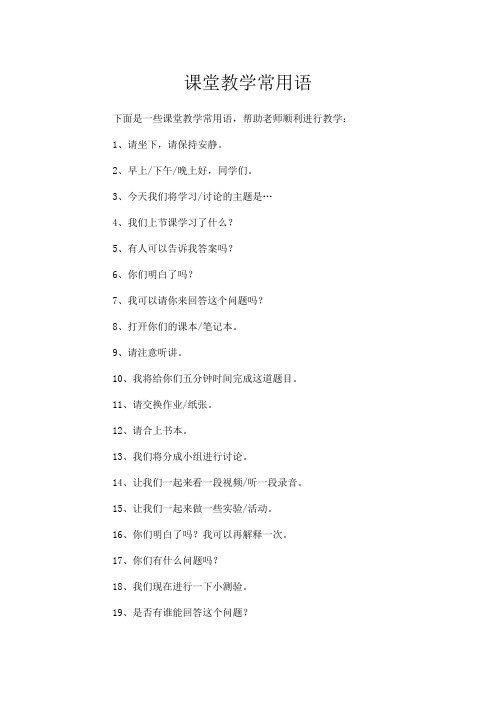
课堂教学常用语下面是一些课堂教学常用语,帮助老师顺利进行教学:1、请坐下,请保持安静。
2、早上/下午/晚上好,同学们。
3、今天我们将学习/讨论的主题是…4、我们上节课学习了什么?5、有人可以告诉我答案吗?6、你们明白了吗?7、我可以请你来回答这个问题吗?8、打开你们的课本/笔记本。
9、请注意听讲。
10、我将给你们五分钟时间完成这道题目。
11、请交换作业/纸张。
12、请合上书本。
13、我们将分成小组进行讨论。
14、让我们一起来看一段视频/听一段录音。
15、让我们一起来做一些实验/活动。
16、你们明白了吗?我可以再解释一次。
17、你们有什么问题吗?18、我们现在进行一下小测验。
19、是否有谁能回答这个问题?20、今天的课堂任务是完成这个项目/作业。
21、非常好,你们做得很棒。
22、所有人都理解了吗?还有其他问题吗?23、我们将开始这节课的新内容。
24、我们将进一步探讨这个主题。
25、大家可以自由发表自己的意见。
26、我将给你们一些例子来解释这个概念。
27、请注意这个关键词/概念。
28、让我们来讨论这个案例/问题。
29、我想听听你们对这个问题的看法。
30、让我们来看一些例子/实例。
31、你们明白了吗?需要再解释一遍吗?32、你们可以自己尝试解决一下这个问题。
33、让我们来复习一下上节课的内容。
34、请你们互相交流,分享一下你们的想法。
35、我们将一起来解决这个难题。
36、让我给你们一些建议来帮助解决这个问题。
37、我将给你们一些提示来帮助你们完成作业。
38、你们需要在周五之前完成这个项目。
39、让我们一起来评估一下你们的表现/作品。
40、非常好,你们真棒!41、请你们做一下课后反思,写下你们的学习心得。
42、请你们做一下课堂总结,总结一下今天学到的内容。
43、让我们一起来唱一首歌/做一些体操活动来放松一下。
44、非常感谢你们的合作和参与。
英语教师课堂用语

情景教学用语
2、在图书馆(In the library)
A: Excuse me, could you tell me where the books about English are?
B: Let me see. They are on the third floor, in the English section
教学常用语
8、作业(Homework)
A: Remember to do your homework. Don't forget B: Yes, I will. Thank you, teacher
3 情景教学用语
情景教学用语
1、打电话(Making phone calls)
A: Hello, this is [ your name]. Is that [ the person you are calling]? B: Yes, this is [ the person you are calling]. Who is that?
B: Thanks for your advice. I'll try again
教学常用语
3、建议(Suggestion)
A: Why don't you try another way? Maybe that will work B: I'll try it. Thanks for your advice
A: Have you finished your homework? B: Yes, we have. / No, we haven't
组织教学用语
5、安静(Be quiet)
A: Please be quiet B: OK
小学语文课堂教学用语50句(2)
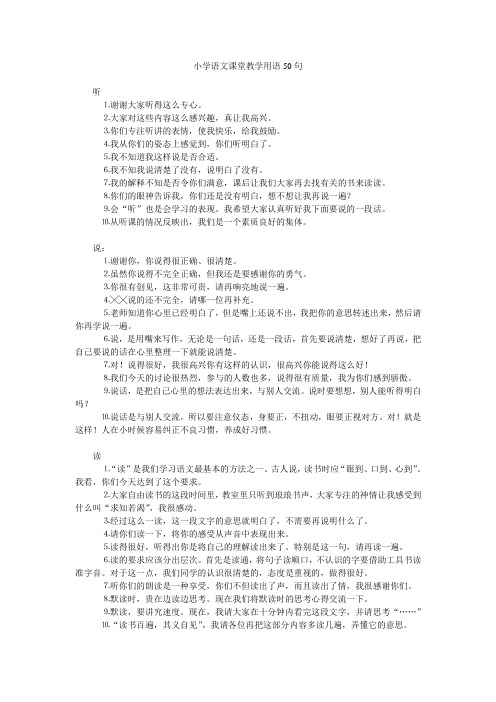
小学语文课堂教学用语50句听⒈谢谢大家听得这么专心。
⒉大家对这些内容这么感兴趣,真让我高兴。
⒊你们专注听讲的表情,使我快乐,给我鼓励。
⒋我从你们的姿态上感觉到,你们听明白了。
⒌我不知道我这样说是否合适。
⒍我不知我说清楚了没有,说明白了没有。
⒎我的解释不知是否令你们满意,课后让我们大家再去找有关的书来读读。
⒏你们的眼神告诉我,你们还是没有明白,想不想让我再说一遍?⒐会“听”也是会学习的表现。
我希望大家认真听好我下面要说的一段话。
⒑从听课的情况反映出,我们是一个素质良好的集体。
说:⒈谢谢你,你说得很正确、很清楚。
⒉虽然你说得不完全正确,但我还是要感谢你的勇气。
⒊你很有创见,这非常可贵,请再响亮地说一遍。
⒋╳╳说的还不完全,请哪一位再补充。
⒌老师知道你心里已经明白了,但是嘴上还说不出,我把你的意思转述出来,然后请你再学说一遍。
⒍说,是用嘴来写作,无论是一句话,还是一段话,首先要说清楚,想好了再说,把自己要说的话在心里整理一下就能说清楚。
⒎对!说得很好,我很高兴你有这样的认识,很高兴你能说得这么好!⒏我们今天的讨论很热烈,参与的人数也多,说得很有质量,我为你们感到骄傲。
⒐说话,是把自己心里的想法表达出来,与别人交流。
说时要想想,别人能听得明白吗?⒑说话是与别人交流,所以要注意仪态,身要正,不扭动,眼要正视对方。
对!就是这样!人在小时候容易纠正不良习惯,养成好习惯。
读⒈“读”是我们学习语文最基本的方法之一。
古人说,读书时应“眼到、口到、心到”。
我看,你们今天达到了这个要求。
⒉大家自由读书的这段时间里,教室里只听到琅琅书声,大家专注的神情让我感受到什么叫“求知若渴”,我很感动。
⒊经过这么一读,这一段文字的意思就明白了,不需要再说明什么了。
⒋请你们读一下,将你的感受从声音中表现出来。
⒌读得很好,听得出你是将自己的理解读出来了。
特别是这一句,请再读一遍。
⒍读的要求应该分出层次。
首先是读通,将句子读顺口,不认识的字要借助工具书读准字音。
教师课堂指令用语

1.集体力量是强大的,你们小组合作了吗?你能将这个原理应用于生活吗?你的探究目标制定好了吗?2.自学结束,请带着疑问与同伴交流。
3.学习要善于观察,你从这道题中获取了哪些信息?4.请把你的想法与同伴交流一下,好吗?5.你说的办法很好,还有其他办法吗?看谁想出的解法多?二、赏识类1.说得太好了,老师佩服你,为你感到骄傲!2.你的设计(方案、观点)富有想象力,极具创造性。
3.我非常欣赏你的想法,请说具体点,好吗?4.某某同学的解题方法非常新颖,连老师都没想到,真厉害!5.让我们一起为某某喝彩!同学们在学习过程中,也要敢于猜想,善于猜想,这样才能有所发现,有所创造!三、表扬类1.你真让人感动,老师喜欢你的敢想、敢说、敢问和敢辩,希望你继续保持下去。
2.这么难的题你能回答得很完整,真是了不起!你是我们班的“小爱因斯坦”。
3.你预习的可真全面,自主学习的能力很强,课下把你的学习方法介绍给同学们,好不好?4.哎呀,你的见识可真广,懂得这么多的知识,好像百度一样,同学们以后有问题要就找你帮忙。
5.通过你的发言,老师觉得你不仅认真听,而且积极动脑思考了,加油哇!四、提醒类1.你虽然没有完整地回答问题,但你能大胆发言就是好样的!2.老师真想在下节课看到你更出色的表现——更踊跃,更大胆,更自信!3.你的声音真好听,能大声读一遍吗?那样,你会获得更热烈的掌声。
4.这道题,你不是不会,而是疏忽大意了,如果再耐心细致些就好了。
5.如果你能脱稿,并且面向同学来展示就更好了。
五、劝诫类1.你是聪明、可爱的孩子,可是你学习不稳定,为什么呢?你经常忘记老师布置的作业,老师多么希望你从小养成做事认真的习惯,对了,还要把上课做小动作的毛病改掉,好吗?老师相信你!2.每次见到老师,你总是甜甜地问一声“老师好!”老师非常喜欢你,但在课堂上,老师多想看到你高高地举起小手呀!不要把手放在角落里,好吗?要展示给别人看,相信自己!3.爱读书,是一个好事情,值得表扬。
课堂教学教师精彩用语

课堂教学教师精彩用语(1)★“老师也不如你。
”或“老师也学到了新知识。
”案例:一名教师在讲授“比的认识”时师:比的后项相当于除法中的除数,相当于分数中的分母,除数与分母都不能为零,所以,比的后项也不能为零……生:(一名学生举手发言)老师,昨天晚上足球比赛,韩国队“三比零”战胜中国队,这个零不是比的后项吗?师:哎(教师略有所思,表现出一副比较茫然的样子)这个问题老师还真没想过,谁能够解答这个问题。
生:我认为这里的三和零都是指进球数,不具有相除关系。
生:我认为这里的三比零是表示记分的一种方法,而不具有比的意义。
生:这里的三比零不能写成3/0……师:噢,(教师恍然大悟的样子)你们说的很有道理,今天“老师也不如你”或“老师也学到了新知识”(众生表现出成功的自豪感和成就感)点评:一位教育专家曾经说过:“如果我们教给孩子的仅仅是知识,那就直接告诉学生好了”。
教师在课堂上看似“不知所措”,其实可能已“胸有成竹”,教师在学生面前贬低了自己,检讨了自己,也正反衬了学生的“英明”。
教师及时给学生一个赞许,一次鼓励,看似平淡的、无痕的,但在学生的心理却能够感受到被“赞许”和“激励”的幸福,感受到成功的喜悦。
在学生面前,老师丢面子了吗?没有,相反,教师收获的是学生的信任与教育的成功。
★你真了不起!你太聪明了!★老师为你的进步感到高兴!老师和同学都相信你会说得很好!★请坐!(不要说坐下吧!)、请你回答这个问题。
(要用“请”字。
)★你的回答比沉默更有风度!说明:此话适用于不敢举手回答问题的学生。
有的学生怕回答问题,一旦答错了,没面子。
有的老师再批评一两句,就更无地自容了。
这时常常用这句话鼓励他们,让学生勇于思考,敢于发表自己的观点,这样课堂上就活跃起来,不再沉默,死气沉沉了。
因为谁都有风度,有价值。
★再想想,办法总比问题多。
说明:如今的社会,独生子女越来越多,学习科目越来越多,需要自己动脑筋解决问题的时间越来越少。
天长日久,连一些稍复杂的学习题目很多学生懒得动脑思考了,他们的理由是“我不会”,一些不肯动脑筋的学生“我不会”就成了他们逃避问题的挡箭牌,这时候,我从不让他们轻易坐下,而是经常鼓励他们说:“让‘我不会’埋进坟墓吧,动动你的脑子再想想,办法总比问题多”,坚信自己“我行,我行,我一定行”,时间长了,还真有效果。
英语课堂用语(二)

日常口语晨间接待1 Hi!你好!2 Hello!你好!3 Good morning.早上好!5 A:How are you ?你好吗?6 B:I'm fine,thank you.And you ?我很好,谢谢.你呢?7 A:Fine,thanks.我很好.谢谢.8 Today is English Day.Please speak English.今天是英语日,请讲英语.9 No Chinese on English Day.英语日不讲汉语.10 Practice more.多练习.11 Don't be shy.不要怕羞.12 Be brave.要勇敢.13 Open your mouth.张开嘴.14 Please say bye-bye to your Mum (Dad...).请跟你妈妈(爸爸)说再见.15 Wave your hands.摇摇手.16 Can I help you?需要帮助吗?17 Do you need any help?需要帮助吗?18 Take off your coat,please.请脱去你的外衣.19 Say hello to your little friends.向小朋友问好.20 Who brought you here today?今天谁送你来的?21 I haven't seen you for a long time.我很久没有见你了。
22 What happened to you? Were you sick?你怎么了?不舒服吗?23 Are you better?你好些了吗?24 Are you feeling better?你感觉好些了吗?31 Please put the chairs down.请把椅子放下来。
32 Who is on duty today?谁是今天的值日生?33 Today you are late. Arrive on time tomorrow.(Get here earlier tomorrow.) 你来晚了,明天按时来。
英语课堂用语2
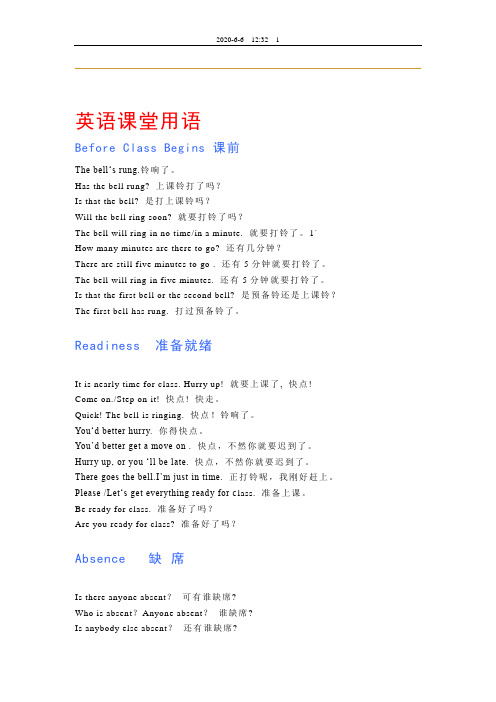
英语课堂用语Before Class Begins 课前The bell‘s rung.铃响了。
Has the bell rung? 上课铃打了吗?Is that the bell? 是打上课铃吗?Will the bell ring soon? 就要打铃了吗?The bell will ring in no time/in a minute. 就要打铃了。
1` How many minutes are there to go? 还有几分钟?There are still five minutes to go . 还有5分钟就要打铃了。
The bell will ring in five minutes. 还有5分钟就要打铃了。
Is that the first bell or the second bell? 是预备铃还是上课铃?The first bell has rung. 打过预备铃了。
Readiness 准备就绪It is nearly time for class. Hurry up! 就要上课了, 快点! Come on./Step on it! 快点! 快走。
Quick! The bell is ringing. 快点!铃响了。
You‘d better hurry. 你得快点。
You’d better get a move on . 快点,不然你就要迟到了。
Hurry up, or you ‘ll be late. 快点,不然你就要迟到了。
There goes the bell.I’m just in time. 正打铃呢,我刚好赶上。
Please /Let‘s get everything ready for c lass. 准备上课。
Be ready for class. 准备好了吗?Are you ready for class? 准备好了吗?Absence 缺席Is there anyone absent?可有谁缺席?Who is absent?Anyone absent?谁缺席?Is anybody else absent?还有谁缺席?Who is absent/missing today?/Who isn‘t here? 今天谁缺席?What’s the matt er with Tom today? 汤姆今天怎么啦?Has anybody seen Bill today? 有谁今天看见过比尔吗?What‘s wrong with Mary today? 玛丽今天有什么不舒服吗?Has anybody any idea where Green is today? 有谁知道格林今天在哪儿?Why is Brown absent? 布朗为什么缺席?I don’t know why he is absent. 我不知道他为什么没来。
原创教师公开课课堂评价用语 (2)

原创教师公开课课堂评价用语一、导言教学评价是教师教学过程中重要的组成部分,通过评价可以了解学生的学习情况、检查教学效果以及引导教学改进。
教师公开课作为一种常见的教学活动形式,旨在向其他教师展示一堂优秀的课堂,促进教学经验的分享和交流。
因此,在教师公开课中,教师的课堂评价用语应具有专业性、客观性和具体性。
本文将给出一些原创的教师公开课课堂评价用语,以帮助教师更好地评价课堂,提升教学质量。
二、评价语句1. 引出课题•这节课的教学目标明确,能够有效激发学生学习兴趣。
•课堂导入生动活泼,吸引了学生的注意力。
•通过引发学生的思考,成功激发了他们对课题的兴趣。
2. 课堂组织•整节课的教学过程有条不紊,组织严密。
•课堂时间分配合理,充分利用了每一分钟。
•从教学内容到教学活动的安排,都有明确的目标和思路。
3. 教学手段与方法•使用了多媒体教学手段,增强了教学效果。
•创设了情境,激发了学生自主学习的动力。
•合理运用了小组合作学习,促进了同学们的互动合作。
4. 师生互动•教师在课堂上能够积极引导学生参与讨论。
•教师及时回应学生提问,给予了鼓励和耐心解答。
•教师可以更多地引导学生进行自主探究,开放性问题的设计也很合理。
5. 学习态度与情感态度•学生在课堂上表现出积极的学习态度,踊跃回答问题。
•学生之间表现出良好的合作精神,互相帮助,共同进步。
•学生们对学习内容表现出浓厚的兴趣,积极参与课堂活动。
6. 教学效果•教学目标基本实现,学生对课堂内容有了较好的掌握。
•学生在本堂课中的思维能力和创造性思维得到了良好的培养。
•通过课堂的教学活动和讨论,学生的问题解决能力和团队合作能力得到了提升。
7. 课堂管理和纪律•教师能够有效地管理课堂秩序,保持了良好的学习氛围。
•学生在课堂中遵守纪律,表现出良好的学习礼仪。
•教师对学生的行为进行了及时的引导和纠正,维护了课堂纪律。
三、总结教师公开课课堂评价用语应该具有客观性、具体性和专业性。
教师课堂过渡类用语

过渡类课堂用语
过渡类课堂用语1:接下来,我们来聚焦这个新主题
使用场景:用于引入新课题或主题,帮助学生从当前话题平稳过渡到下一个学习内容。
示例:好了,同学们,我们刚才讨论了动物的生活习性,接下来,我们来聚焦这个新主题——植物的生长过程,大家准备好和我一起探索了吗?
过渡类课堂用语2:现在,请大家把注意力转向这里
使用场景:当需要吸引学生的注意力,从其他事物或活动回到课堂上时。
示例:同学们,我看到有些同学在低头看课外书,现在,请大家把注意力转向这里,我们要开始讲一个新的数学问题了。
过渡类课堂用语3:那么,我们接下来要做的是……
使用场景:用于告知学生接下来要进行的课堂活动或任务,帮助学生明确下一步行动。
示例:好了,同学们已经完成了上一个练习题,那么,我们接下来要做的是进行小组讨论,关于如何更好地保护环境,大家开始行动吧!
过渡类课堂用语4:让我们回顾一下刚才的内容
使用场景:在转换话题或进行新活动之前,回顾之前学过的知识点或讨论的内容,确保学生理解并巩固记忆。
示例:在我们开始新的科学实验之前,让我们回顾一下刚才学习的关于水的性质,这样我们就能更好地理解和完成接下来的实验了。
过渡类课堂用语5:现在,请大家思考一下这个问题
使用场景:用于激发学生的思考,引导他们进行深入探讨或提出自己的观点。
示例:同学们,现在请大家思考一下这个问题:如果我们生活中没有电,会发生什么呢?请大家举手发表自己的看法,我们一起探讨一下。
教师精彩课堂用语50句

教师精彩课堂用语50句1. 同学们,上课了,请坐好。
2. 早上好,同学们!3. 请拿出课本和笔记。
4. 今天我们将学习一个新的知识点。
5. 在开始之前,我们先来回顾一下上节课的内容。
6. 请大家打开课本,第几页,第几行。
7. 我将在黑板上写下重点内容,请大家认真听讲。
8. 如果有任何问题,请随时举手提问。
9. 让我们来参与一个小组讨论。
10. 请跟我一起念第一段对话。
11. 请你读文本的第二段。
12. 请你总结一下我们刚才学习的重点。
13. 我将把问题列在黑板上,请大家思考一下如何回答。
14. 请你们发表一下你们的观点。
15. 让我们做一个小测验来检验一下你们的理解程度。
16. 大家请组成一个小组,共同完成这个任务。
17. 我将分发一份练习题,请大家自行完成。
18. 让我们来做一个小游戏,用来巩固刚才学到的知识。
19. 你们觉得应该如何解决这个问题?20. 请同学们分析一下这个实验的结果。
21. 你对这个话题有什么更深入的了解?22. 请同学们分组进行角色扮演。
23. 让我们一起来演示一下这个化学实验。
24. 请大家回答一下这个问题的正确答案。
25. 让我们来听一段录音,然后回答几个关于录音内容的问题。
26. 让我们讨论一下这个数学问题的策略。
27. 请同学们将你们的观点写下来。
28. 请你们和你的伙伴一起合作完成这个任务。
29. 让我们来分享一下我们的想法。
30. 学生A,请你向学生B解释一下你的答案。
31. 你们有谁有不同的观点?32. 请大家拿起你们的手中的实验器材。
33. 让我们跟着录音一起来读这篇课文。
34. 请大家保持安静,听我读这段文章。
35. 让我们来辩论一下这个问题,并列出正反双方的观点。
36. 同学们,现在我们来进行一次思维导图练习。
37. 请你们把这个问题的答案解释给我们。
38. 同学们,请你们在纸上作答。
39. 让我们来分析一下这道数学题的解题步骤。
40. 请你们把这个实验步骤写下来。
学生课堂精彩用语
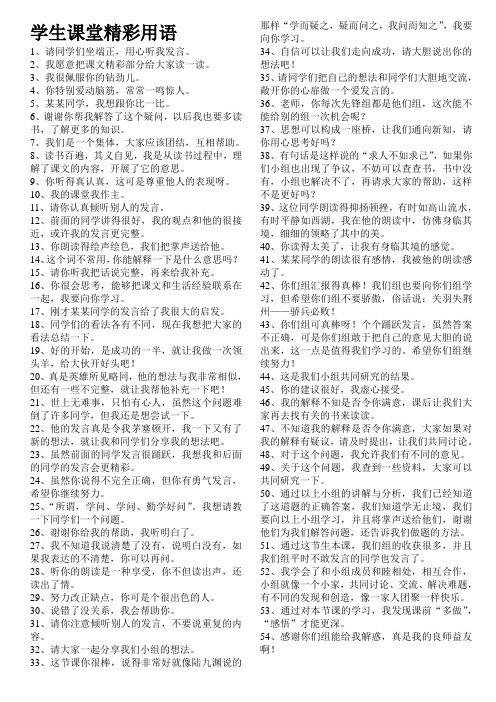
学生课堂精彩用语1、请同学们坐端正,用心听我发言。
2、我愿意把课文精彩部分给大家读一读。
3、我很佩服你的钻劲儿。
4、你特别爱动脑筋,常常一鸣惊人。
5、某某同学,我想跟你比一比。
6、谢谢你帮我解答了这个疑问,以后我也要多读书,了解更多的知识。
7、我们是一个集体,大家应该团结,互相帮助。
8、读书百遍,其义自见,我是从读书过程中,理解了课文的内容,开展了它的意思。
9、你听得真认真,这可是尊重他人的表现呀。
10、我的课堂我作主。
11、请你认真倾听别人的发言。
12、前面的同学讲得很好,我的观点和他的很接近,或许我的发言更完整。
13、你朗读得绘声绘色,我们把掌声送给他。
14、这个词不常用,你能解释一下是什么意思吗?15、请你听我把话说完整,再来给我补充。
16、你很会思考,能够把课文和生活经验联系在一起,我要向你学习。
17、刚才某某同学的发言给了我很大的启发。
18、同学们的看法各有不同,现在我想把大家的看法总结一下。
19、好的开始,是成功的一半,就让我做一次领头羊,给大伙开好头吧!20、真是英雄所见略同,他的想法与我非常相似,但还有一些不完整,就让我帮他补充一下吧!21、世上无难事,只怕有心人,虽然这个问题难倒了许多同学,但我还是想尝试一下。
22、他的发言真是令我茅塞顿开,我一下又有了新的想法,就让我和同学们分享我的想法吧。
23、虽然前面的同学发言很踊跃,我想我和后面的同学的发言会更精彩。
24、虽然你说得不完全正确,但你有勇气发言,希望你继续努力。
25、“所谓,学问、学问、勤学好问”。
我想请教一下同学们一个问题。
26、谢谢你给我的帮助,我听明白了。
27、我不知道我说清楚了没有,说明白没有,如果我表达的不清楚,你可以再问。
28、听你的朗读是一种享受,你不但读出声,还读出了情。
29、努力改正缺点,你可是个很出色的人。
30、说错了没关系,我会帮助你。
31、请你注意倾听别人的发言,不要说重复的内容。
32、请大家一起分享我们小组的想法。
小学英语教师常用课堂用语200句 (2)
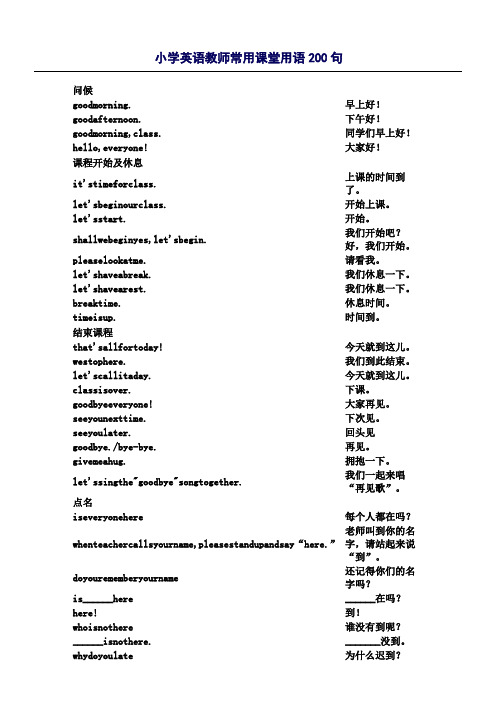
问候goodmorning. 早上好!goodafternoon. 下午好!goodmorning,class. 同学们早上好!hello,everyone! 大家好!课程开始及休息it'stimeforclass. 上课的时间到了。
let'sbeginourclass. 开始上课。
let'sstart. 开始。
shallwebeginyes,let'sbegin. 我们开始吧?好,我们开始。
pleaselookatme. 请看我。
let'shaveabreak. 我们休息一下。
let'shavearest. 我们休息一下。
breaktime. 休息时间。
timeisup. 时间到。
结束课程that'sallfortoday! 今天就到这儿。
westophere. 我们到此结束。
let'scallitaday. 今天就到这儿。
classisover. 下课。
goodbyeeveryone! 大家再见。
seeyounexttime. 下次见。
seeyoulater. 回头见goodbye./bye-bye. 再见。
givemeahug. 拥抱一下。
let'ssingthe"goodbye"songtogether. 我们一起来唱“再见歌”。
点名iseveryonehere 每个人都在吗?whenteachercallsyourname,pleasestandupandsay“here.”老师叫到你的名字,请站起来说“到”。
doyourememberyourname 还记得你们的名字吗?is______here ______在吗?here! 到!whoisnothere 谁没有到呢?______isnothere. _______没到。
whydoyoulate 为什么迟到?what'sthematter 发生了什么事情?comein,please. 请进。
- 1、下载文档前请自行甄别文档内容的完整性,平台不提供额外的编辑、内容补充、找答案等附加服务。
- 2、"仅部分预览"的文档,不可在线预览部分如存在完整性等问题,可反馈申请退款(可完整预览的文档不适用该条件!)。
- 3、如文档侵犯您的权益,请联系客服反馈,我们会尽快为您处理(人工客服工作时间:9:00-18:30)。
高校英语教师课堂常用语汇编(1). What to say when beginning a lesson1. Now it’s time for us to have class.2. Is that the first bell or the second bell?3. There goes the bell. Now class begins.4. Now let me call the roll.5. Let me check up on you.6. Is anybody absent today?7. Everyone is here except Bill.(student on duty)8. Excuse me for being late, Mr.Smith.(A student)9. Why is Bill absent?10. Please come earlier next time.11. Now let’s begin the new lesson.12. Please open your books and turn to page 9.13. Let’s get down to some work.(2). What to say when announcing the teaching plan1. We are going to take up a new lesson today.2. Today we’ll conduct the lesson in this way.3. To begin with, I want you to look at the dialogue on page 7.4. Before we take up the new lesson, we are going to review lesson 2.5. This is the 4th period on lesson6. In this period we’ll start with the revision of the first part of the text.6. The aim of this lesson is to teach the use of “some” and “any”.7. We shall have dictation first. Pay attention to the pronunciation and your handwriting.8. If we have time, we’ll have a short quiz.9. Where did we stop/leave off last time?(3). What to say when teaching phonetics1. Notice how my tongue touches my teeth.2. This is a front/central/back vowel.3. Your lips should be spread/loosely spread/rounded.4. transcribe in phonetic symbols what you have heard.5. You’d better use the falling tone here.6. We must pay attention to sentence stress/sense groups/liaisons.7. Put some feeling into your reading.8. Your should not pause in the middle of a sense group..9. You’ve read quite well except for one place…10. You’ve mispronounced the word… Now listen to me carefully.11. Say…after me.(4). what to say when teaching new words1. The word can be used either as a noun or a verb.2. Can you spell the word “blackboard”?3. What does the word “…” mean?4. What does the “…” stand for in the lesson?5. What is the implied meaning of the word “…” in the context?6. Don’t confuse the phrase“be used to” with “used to”.7. Can you distinguish/tell the difference between …and…?8. Can you think of any word to replace it?9. Please tell me what part of speech the word “…”is.10. And do you know its adjective form?11. Now remember that the word “sheep” has the same form in the singular as in the plural.12. The phrase “look out” here has another meaning. It’s a warming which means “be careful”.13. Please make a sentence with this phrase.14. Could you give the Chinese equivalent of the phrase?15. Give a synonym and an antonym for this word.16. Do you know another English word which means the same thing?(5). What to say when teaching the text1. Now the text. The short text is selected/ adapted from a short story/magazine/novel etc.2. I shall tell you something about the author’s life.3. I shall give you the general idea of the text.4. We’ll read this paragraph first and then explain the difficult sentences.5. Please analyze the second sentence in paragraph 2.6. Can you paraphrase this sentence?7. Can you retell this sentence in a way easy to understand?8. I think it can be understood from the context.9. Now I’ll read the text once more. Please listen carefully.10. Don’t hesitate to ask me, if anything is not clear.11. What’s the function of the clause introduced by “that” in this complex sentence?12. These two sentences are the same in form but different in function.13. What’s your impression of the story?14. Raise your hand if you can’t follow me.15. Say something about what you have learned from(about)the hero.(6). What to say when teaching grammar1. You should have used the future tense, not the present.2. The definite article has been left out here.3. You should not have made such a serious mistake.4. The predicate verb must agree with its subject in person and number.5. Let’s not forget the sequence tense.6. Point out the subject / the predicate / the object / the adverbial, etc.7. The first letter of a proper noun must be capitalized.8. what kind of verb is “get” here?9. It’s a link verb.10. Do not be confused about the usage of the past tense and the present perfect tense.11. Please explain why the order of the sentence is inverted.12. How does a gerund differ from a present participle?13. How about changing direct speech to indirect speech?14. Your sentence is grammatically correct, but idiomatically not. It should be…15. Can you replace the attributive clause with a participle phrase?(7). What to say when doing oral work1. Now let’s do the questions and answe rs on the text in pairs.2. Listen carefully and see whether his answer is correct.3. Can you improve on his answer? / Can you make it better?4. Does anybody share his view?5. Now look at the pictures on page 34 and try to tell the story in your own words.6. Well, I’ll ask two students to give us a dialogue on this topic. Who will be the pair to speak?7. Use your imagination while talking about the pictures.8. Speak clearly so as to make yourself understood.9. Now we’ll have discussion. You’re supposed to say something about…10. How do you explain the idea in simple English?11. Would you like to / will you speak a bit louder?12. Certainly. / Yes, I will.13. Please speak a bit louder.(8). What to say when written exercise1. Copy them into your exercise books.2. Write sentences after the given model.3. Write a short passage using these phrases.4. what did you put for No.3?5. See if you can put the verb in the right form.6. Exchange papers with somebody nearby / your partner.7. Mark the right / wrong answer with a tick / cross.8. Give yourself one point for every correct answer.9. Which of the four choices best completes the sentence?10. C is the right choice. It fits the sentence idiomatically.11. Make sure to write them out clearly in your exercise book.12. Please hand in clear copies.13. You’ve make good progress. But there is still much room for improvement.14. You must strive to work harder, otherwise, you won’t be able to catch up with your classmates.(9). What to say when doing translation and composition work1. We’ll have translation exercises today.2. Can you translate it into English / Chinese for me?3. Translate from Chinese / English into English / Chinese.4. What’s wrong with this translation?5. Who can give a better version?6. Is the translation true to the original?7. Now let’s talk about how to write good compositions?8. You must work out an outline before writing.9. Make a draft first, then copy it into your composition books.10. Write a composition about 350 words.11. Write a composition about what you’ve learned from…(10). What to say when teaching handwriting1. Write it in block letters / in print / in italics / in capital letters / in small letters.2. Copy these words five times.3. Write on every other line.4. Your handwriting is illegible.5. Write more slowly and carefully. Don’t scribble.6. Write from memory the English alphabet.7. We start each new paragraph on a new line.8. To begin each sentence, we should capitalize the first letter of the first word.9. Don’t forget to put a full stop at the end of each sentence, or to put a question mark if it is a question.10. Make sure I can read your handwriting.11. I can’t make out your handwriting.12. Leave space between each word. I hope your exercise books will be clean and tidy.13. I’s afraid you will have to recopy it.(11). What to say when organizing blackboard activity1. Go / Come to the blackboard.2. Take a piece of chalk and write the sentence / word out.3. Write it next to / above / below that word.4. Try to keep your handwriting straight / level.5. Move out of the way so that everyone can see.6. Can you see anything wrong with sentence 4?7. Erase the last letter.8. Would you go and fetch some chalk for me, please?9. Where is the eraser / sponge / duster?10. Clean the blackboard, please.11. Leave the answers on the board. You didn’t do it well this time, did you?12. No, I didn’t. let me try again.(12). What to say when organizing role playing1. Now let’s act out this conversation / little play.2. Any volunteers? I’d like to act the part of …3. Who would like to be…? Come to the front, please.4. Mr.Wang, you play the role of …And the rest of you are audience. Any problems?5. Who would like to act the scene for us?6. try to manage without your book, please.7. Let’s rehearse first.8. Pretend that you are a teacher.9. I think we should clap.(13). What to say when teaching in the sound lab1. Now, first of all, I’d like you to get familiar with the machines you’re to use.2. So switch the machine on.3. Could you plug the recorder in, please?4. Pull the plug out of the wall. / Unplug the recorder.5. Check whether your microphone is switched on.6. Make sure your number counter is at zero.7. Press your call button if you have any problems.8. Listen carefully to the instructions.9. while listening, mark your answer sheet.10. Hang up your headphones before you leave.11. Pull down / Roll up the screen.12. I’m going to show you some slides of English.13. Adjust the focus, please.(14). What to say when controlling the classroom1. Eyes to the front, please.2. Look at me / the backboard.3. Pay attention now. / Could I have your attention?4. May I have your attention, please?5. Try to concentrate now.6. Silence / Attention, please.7. Don’t shout / make any noise.8. Settle down, all of you.9. Don’t keep turning around.10. Stop fidgeting / messing around / playing the fool.11. Behave yourself.12. Word in twos / pairs / threes / fours, etc.13. Form into groups of three, etc.14. work on your own. / Everybody works individually.15. No cheating / peeping / whispering.(15). What to say when giving assignments or dismissing class1. Now for your homework. Please do Exercises 5 on page 41 in you exercise books.2. For today’s homework, make sentences out of the words on the blackboard.3. Learn the text by heart and do the exercises on page 20.4. Your homework today is to prepare the last two paragraphs for Monday.5. Finish this off at home.6. Hand in your exercise books tomorrow.7. I’m not going to give you any homework this time.8. We’ll leave off here today.9. class (is) dismissed.10. Let’s have a break.11. See you tomorrow / next week / on Wednesday.。
